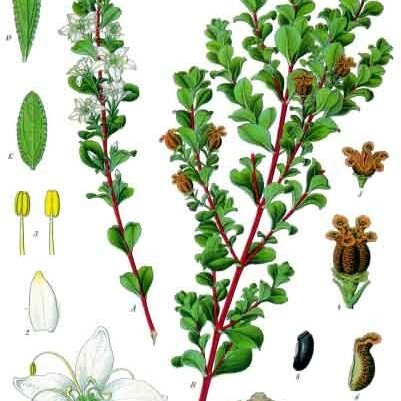Branchlets warted, glabrous. Leaves mostly 1-2 cm long, opposite or alternate, erect-spreading, slightly recurved at the apex, obovate, sometimes very widely so, obtuse, cuneate towards the base, serrate, glabrous, concave up the middle, convex at the margin, with a conspicuous primary nerve and often with secondary nerves beneath, with marginal and scattered glands beneath. Flowers solitary at the ends of very short axillary branchlets bearing very much reduced leaves. Peduncles about 1 mm long, glabrous, with lanceolate ciliolate bracteoles near the base. Sepals 2.5-3 mm long, lanceolate or ovate-lanceolate, obtuse, ciliolate, puberulous above on the upper half, obtusely keeled beneath. Petals 0.8-1 cm long, ovate-lanceolate or elliptic-oblong, very obtuse, cuneate in the lower half, glabrous or sparsely pubescent above, ± ciliolate or ciliate, slightly swollen behind the apex, with many glands beneath near the nerve. Stamens with pubescent filaments. Staminodes 3.5 mm long, oblong-lanceolate, obtuse, tapering towards the base, gland-tipped, concave above, ciliate, with the margin involute near the apex. Disk fleshy, crenulate. Ovary with 5 carpels having stalked glands at the sides and bearing obovate-rotund dorsally compressed processes sparsely pubescent above ciliate and with marginal swellings at the base. Style recurved, pilose on the lower half.
More
Resprouting, broad-leaved shrub to over 2 m, fragrant. Flowers large, usually solitary, axillary, white to purplish pink. Fruits 5-chambered.
A shrub. It grows 2 m high. The leaves are small, broad and dotted with glands. The flowers are white or pale purple.
The leaves and oil are used for flavouring. An oil extract is used to flavour candy, ice cream and baked goods. The leaves are used in the preparation of brandy. The roots are use as a flavouring and preservative.

